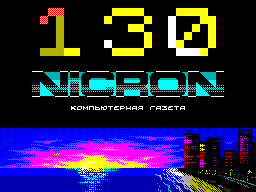|
Nicron #25
20 марта 1997 |
|
Iron - an overview of the microprocessor Zilog Z380, continued.

MPU Z380
(C) WLODEK BLACK
[End. Beginning in room 7].
Management tact of wait
when referring to the lower, upper
and secondary memory
When using the built-in controller memory access
(WCP) can programmatically set the artificial delays in the
engine cycles of treatment to specific habitats for WCP lower,
middle and upper memory.
The structure of the control registers delays the same for all
areas of memory:
7 6 5 4 3 2 1 0
T1W2 T1W1 T1W0 T2W1 T2W0 T3W2 T3W1 T3W0
"T1", "T2" and "T3" is the number of machine cycles of a
machine cycle, and "W2", "W1", "W0" - binary constant weight
programmable delay: for example, an entry in the register
value% 10100000 asks the delay in cycle T1 at 101% = 5
additional cycles.
Economical mode of shutdown
Z380 has a software-controlled shutdown mode is economical,
using which one can achieve a sharp reduction in processor
power and / or a microprocessor. If the regime economically
stop (REO) is allowed to activate REO performed with the
command processor SLP (sleep). After performing SLP stop
listening to the clock outputs BUSCLK and IOCLK; signal at the
output / STNBY becomes logic 0, indicating confirmation of REO,
processor ceases execution of operations; address bus goes into
a logic 1; control bus takes third state. Signal / STNBY can be
used to feed the team a power failure or other devices at least
for locking of the external clock. Exiting REO effected by the
reset of the request Non-maskable interrupt of the request
masked interrupt any type (if permitted EI), as well as a
request to the capture of tires if one is allowed in the
register SR. If the REO is not resolved, the team SLP is
executed as HALT (including exposure confirmation signal /
HALT). REO management by using the control register
REO and return from REO (SMCR). (Address SMCR in EP
UVV-00000016h).
7 6 5 4 3 2 1 0
STBY BRXT - - - WM2 WM1 WM0
Appointment of digits SMCR:
STBY - logic 1 enables the transition to the EMR;
BRXT - logic 1 enables the output of the EMR at the request of
the capture of Tyre; WM2 ... WM0 - set the delay time in the
periods of the fundamental frequency clock, during which the
processor will be held in "limbo" state (literally, "WM" -
Warm-Up time, that is "warm-up time) after leaving the RER,
this time may be necessary for the entry into operation of
other devices, disconnected the signal / STNBY. Installing a
logic 1 sets the bit WM0 delay 2 ^ 16 clock periods, WM1 - 2 ^
17, WM2 - 2 ^ 19. During the warm-up time listening to the
pulses of clock outputs and BUSCLK IOCLK not performed. For all
logic 0 delay is incorrect.
Interrupt system
Interrupt System Structure (PO) Z380 contains compatible with
Z80 and Z180 subgroup, and also includes new elements,
For example, interrupt handling code to the wrong team.
Hardware interrupts are caused by feeding low-level
one of the inputs / NMI, / INT3../INT0.
/ NMI - Non-maskable interrupt input. When handling NMI
processor sends a return address stack, stores the flag
resolution maskable interrupt disables interrupts masked and
moves to address 00000066H, that is similar to Z80. The
difference is that the NMI in the 380-m is not the highest
priority (!) - primarily served by a software interrupt to the
wrong code team (trap). The third level of priority is
interrupted by the entrance / INT0, which is completely
analogous to the usual masquerading interrupt Z80. In
particular, this input supported 4 types of interrupt IM 0, IM
1, IM 2, IM 3. Mode 3 is different from IM IM 2 only using
16-bit vector and the offset: bits A31 .. A16 are given
extended registers I, and bits A15 .. A0 are read from the data
bus in cycle interrupt acknowledgment, in received address is
read a word or long word (depending on the mode of the
processor), which also serves as the address of the transition
to routine servicing. Interrupts / INT1, / INT2, / INT3 (in
descending order of priority) caused by feeding low levels of
the corresponding input, and address the processing procedure
is determined by the so-called associated vector, which is
calculated as follows: A31 .. A16 are taken from the extended
register I; A15 .. A9 determined by the contents of register
AVBR (his address to the EP UVV 00000018H); A8 = 0; A7 .. A0
are, respectively, (16-hex form) 00H for / INT1, 04H - for the
/ INT2, 08H - for the / INT3. According to the calculated
address is read a word or long word (depending on the mode of
the processor), which also serves as a jump address to the
serving process.
AVBR:
7 6 5 4 3 2 1 0
AB15 AB14 AB13 AB12 AB11 AB10 AB9 0
Enable / Disable maskable interrupts by either
teams EI 0 ... EI 3 / INT0.../INT3, either by direct
manipulation of the interrupt enable flags, which are in
Register IER (Interrupt Enable; address in the EP UVV
00000017H) and in the register SR (bit 5). Distribution of
responsibilities between the IER and the 5 th bit SR is as
follows: IER bits indicate only the possibility of interruption
from a particular input / INT 0 .. 3 and 5-th bit SR - this is
interrupt enable flag. Team DI can be at once to ban all masked
interrupts. EI enables interrupts, but only those that are
unlocked in the IER.
IER:
7 6 5 4 3 2 1 0
- - - - IE3 IE2 IE1 IE0
0 0 0 1
Other articles:
Similar articles:
В этот день... 30 December